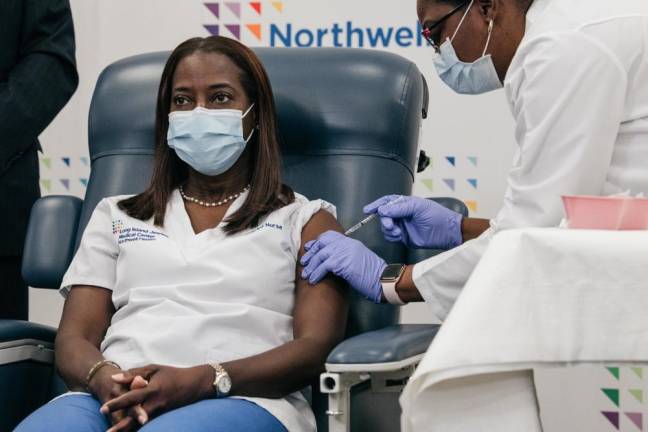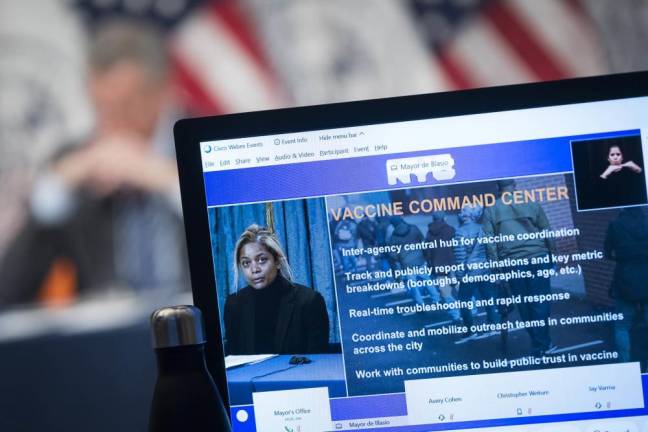The vaccine arrived in New York City Monday just as the coronavirus surged to dangerous levels, creating yet another new normal as good news and bad news competed for our attention and belief.
“It’s like the light at the end of the tunnel has shown us how stinky and bad the tunnel is,” said Kate McKinnon, the Saturday Night Live star and native Long Islander, struggling to stay in character as the show beamed from 30 Rockefeller Center.
Everyone was adapting.
New Yorkers, no strangers to lines, suddenly found themselves considering their place on perhaps the most important line in the city’s history – although the inequities of the military draft during the civil war did spark riots downtown.
All plans for next year pivoted around how quickly the vaccine could be distributed to enough New Yorkers to make us stronger than the virus as a community, or a herd in the language of epidemiologists.
“I feel like healing is coming,” said Sandra Lindsay, a nurse at Northwell Health/Long Island Jewish Hospital in Queens as she received the first injection in the state outside clinical trials. “I hope this marks the beginning of the end of a very painful time in our history.”
Dr. Anthony Fauci, the federal government’s top infectious disease expert, speaking by Zoom to an audience at grand rounds at Columbia’s Mailman School of Public Health, said 75 percent of the population would need to be immune to curtail the virus.
With the virus winning for the moment, Governor Andrew Cuomo focused on protecting hospitals from being overwhelmed by covid-19 patients, as happened last April.
“We are constantly calibrating our strategy with the goal of maintaining as much economic activity as possible, while protecting public health,” he said, explaining that the driving metric would now be the shrinking number of vacant hospital and ICU beds.
The rising case load prompted him to shut indoor dining in New York City little more than two months after allowing it. Restaurant owners and workers protested, but the governor laid his decision “to recently issued CDC guidance emphasizing the high risk of indoor dining.”
The seven day averages of new cases, hospitalizations and deaths were all climbing.
Mayor Bill de Blasio said that a “full shutdown” of the city may be needed “to stop that momentum or else our hospital systems will be threatened.”
A look at some key issues involved with vaccines in NYC:
Supply and Distribution
That light at the end of the tunnel was actually the headlights of UPS trucks arriving with the city’s first doses of the vaccine invented by Pfizer and their German partner BioNTech.
For the next few weeks, there will not even be enough doses to vaccinate all of those in phase one of the governor’s plan - health care workers and residents of elder care facilities.
But by January there should be enough supply of the Pfizer vaccine and a second, from Boston based Moderna, to begin Phase 2, inoculating frontline workers from police to grocery stores and patients with health challenges that make them particularly vulnerable.
“The distribution of the COVID-19 vaccine will undoubtedly go down as one of the most massive governmental operations in history,” Cuomo said.
While the logistics are daunting, the core challenge right now is producing enough vaccine to inoculate everyone. That is why officials have been fuzzy on when the general public will start getting the vaccine or when enough doses will have been administered to bring the pandemic to an end. Timing as divergent as spring and the end of next year have been offered.
Trust and Equity
Beyond supply, the two biggest challenges are trust and equity. The virus has and is spreading more aggressively in low income neighborhoods. So both as a matter of fairness and to effectively corral the virus officials are planning aggressive outreach efforts.
They will have to overcome considerable skepticism about the vaccine as well as concerns, particularly in immigrant neighborhoods, that medical staff would share information with law enforcement. Cuomo has said this will not happen.
With supplies of vaccine short, there is also the question of high-income neighborhoods.
“On the eve of the coronavirus vaccine rollout, an ethically compromised subset of 1-percenters are already scheming about ways to cut the line,” wrote Holly Peterson in Airmail, Graydon Carter’s digital magazine.
After all, this IS New York. Someone is always scheming about ways to cut the line. The stakes, of course, are a good bit higher then finagling past the velvet rope at an after-hours club.
“We will not allow people who are privileged to jump the line,” de Blasio told reporters last week. “We’re not going to allow people to get the vaccine, unless it is their time to get the vaccine. So, for example, someone who does not have preexisting health conditions, someone who’s younger, someone who’s not a frontline health care worker or a first responder should not be getting the vaccine now. Their time will come.”
The Mayor had noted, in an earlier briefing, that his administration would be monitoring low income neighborhoods, which have been far harder hit by the virus, to be certain vaccine was reaching them.
“We’ve got to protect those who serve us and those who are most vulnerable,” the mayor said last week. “And we will enforce that rigorously ... I would say to anyone who thinks that their privilege puts them ahead of other people in greater need, that’s not going to happen in New York City.”
A larger equity question appears to be the many well-to-do older New Yorkers who under the system will get the vaccine early because of their age or health challenges. While they are at greater risk if they contract the virus, many also recognize they have far greater ability to shelter from it by working at home or from what used to be their weekend house.
Several said they would gladly give up their place to someone at greater risk of contracting the virus. This instinct was praised by an ethicist, Professor Robert Prentice of the University of Texas, who has written that we all have a moral obligation, barring serious health issues, to take the vaccine to protect the community.
But Prentice, who is 70 and has a heart condition, said this instinct for sacrifice might do more harm than good in this situation. “When you are doing things on this scale, efficiency demands that lines be drawn, and drawn in a broad way,” he explained. “If the government tried to look at each individual case and rank order all 330 million plus Americans, that would obviously be impossible. So, my fear is that if [the] well-intentioned ... attempt to give our places in line away, it will only impede the process. And that will be bad for everyone.”
“We’ve got to protect those who serve us and those who are most vulnerable. And we will enforce that rigorously.” Mayor Bill de Blasio

